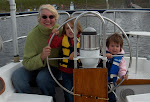Thank you for your interest in my photos, and indeed I did run and named a fine craft show inspired from the Wabi Sabi philosophy.
The name of the show came about when I read a newspaper article about the subject and its relation to arts, simplicity and time's passage. This was in the summer of 2000. It got me thinking of how poorly we showed and appreciated the fine crafts in my neck of the wood. Originality and artistry were taking the back seat to cookie cutter production and mediocre works. Also when I read the article, followed by the book, it is as if I had finally found a name to what I deeply felt living and creating was all about. I found that Wabi Sabi best translated the respect of materials and artistry. So, in 2001, I made contact with fine crafts artists whose works were not defined by trends or time, and at least a little open mind. The show was also perfect for a renovated 100 years old Town Hall, with good natural light and patina.
I lead the show for 5 years, until 2005, when I was physically and emotionally spent. You could say that it was a 5 years project for me, and I did achieve my goals of raising awareness towards quality over quantity, originality, uniqueness, simplicity and local fine crafts artists. The show is still in existence. This year will mark its ninth year in existence.
I feel that more and more as life gets more complicated with unquestioned consumption and wasted resources, that the Wabi Sabi philosophy remains authentic and sane in a chaotic world.
I hope that this answers your question, or at least part of it!
My response, in return:
You have eloquently stated the essence of wabi sabi. Thanks for sharing the process which led you to the creation of your heartfelt exhibition.
I, too, feel that more people understanding and following the philosophy of the Japanese words, which identify their aesthetic, would result in a much less chaotic world. So many people in our world -- even, unfortunately, most of the younger Japanese -- are caught up in the "new, bigger, better" philosophy of consumption.
We had a dairy farm and 4 children for almost 20 years about 20 years ago... (the baby is now 32!) and some of the initial attraction of wabi sabi to me I must admit, was economic. Most of my continued interest, however, is the ability to imbed each created object with your heart and soul. Your objection to kits and the "cookie cutter" mentality is one to which strongly agree! Objects with character and texture and even slight imperfections far outshine their antiseptic counterparts.
I am also attracted to the clean, pure lines of modernism and at first it may seem contradictory, but we have found lovely items that have that sense of history and a bit of wear and tear that show it is well-loved. I love the world of two Japanese artists -- architect Tadao Ando and photographer Hiroshi Sugimoto -- that capture the essence of wabi sabi in a most contemporary way.
Was the book you mentioned: Wabi-Sabi: for Artists, Designers, Poets & Philosophers by Leonard Koren? This is my favorite book on the subject. There is a children's book that was just published that also does an excellent job explaining the wonderful qualities of Wabi Sabi by Mark Reibstein. It's beautifully illustrated!
It's wonderful chatting with you about this. Perhaps we should start a group on Ravelry (and Weavolution) to spread the word!


Hey good buddy! I just caught up with your blog and I had a good time looking at your pictures. I love seeing your boat and your socks! Yes, sock bindoffs are challenging. I normally use a suspended bind off, or a crocheted suspended bind off. The icord bind off is new to me and I liked it a lot. Enjoy your boat time.
ReplyDelete